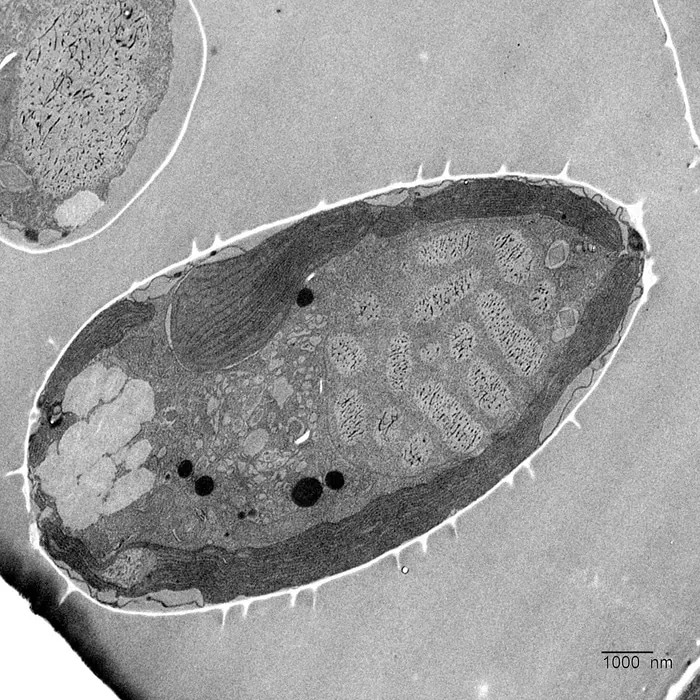Which molecular mechanisms in a species of unicellular marine algae can result in toxic algal blooms? Using both cutting-edge microscopic and proteomics techniques, a research team led by microbiologist Professor Dr Ralf Rabus of the University of Oldenburg has carried out the first comprehensive analyses of the peculiar cell biology of Prorocentrum cordatum, a globally distributed species of the dinoflagellates group.
 Cross-section of a cell of the microalga Prorocentrum cordatum. The nucleus with the chromosomes is on the right. A single barrel-like chloroplast takes up 40% of the cell volume. Image Credit: University of Oldenburg / General and Molecular Microbiology group.
Cross-section of a cell of the microalga Prorocentrum cordatum. The nucleus with the chromosomes is on the right. A single barrel-like chloroplast takes up 40% of the cell volume. Image Credit: University of Oldenburg / General and Molecular Microbiology group.
These microorganisms’ peculiar photosynthesis process, as explained by the team in the scientific journal Plant Physiology, may enable them to more effectively adapt to the shifting light conditions in the ocean. The study's findings contribute to a better understanding of the frequency of harmful algal blooms, which may be increasing in response to climate change.
In freshwater and marine environments alike, dinoflagellates are vital organisms. A significant amount of the free-living phytoplankton that serves as the foundation of the food web in lakes and oceans is composed of these unicellular organisms. Certain species, such as Prorocentrum cordatum, can multiply and create toxic algal blooms in warm, nutrient-rich waters.
We studied this organism because despite its environmental relevance its cell biology and metabolic physiology are still poorly understood.”
Dr Ralf Rabus, Professor and Microbiologist, University of Oldenburg
Together with teams from the Universities of Hanover, Braunschweig, and Munich, the researchers not only studied photosynthesis in the microalgae but also looked at the structure of their cell nuclei and how they responded to heat stress. Their findings were published in two other papers.
The team led by Rabus and study lead author Jana Kalvelage from the Institute of Chemistry and Biology of the Marine Environment (ICBM) was able to reconstruct the three-dimensional architecture of the chloroplasts, where photosynthesis occurs, using a powerful scanning electron microscope with a focused ion beam at the Ludwig-Maximilians-Universität Munich.
The oval-shaped, single-celled organisms are typically between 10 and 20 thousandths mm long. The scientists were able to produce about 600 image layers of a single algae cell and then combine the sections to create a three-dimensional, high-resolution spatial image of the organisms. According to the analysis, Prorocentrum cordatum only has one barrel-shaped chloroplast, which makes up 40% of the cell volume.
Subsequently, proteomic (protein) analyses demonstrated notable distinctions between the photosynthetic machinery of the microalgae and that of Arabidopsis thaliana, a model plant extensively researched in genetics.
In both species, the complex protein structures that are embedded in the vast membrane system of the chloroplast are the site of photosynthesis. In contrast, the team found that in Prorocentrum cordatum, the various stages of photosynthesis are carried out in spatially separated structures in the chloroplasts of the plant species’
In Prorocentrum, the conversion of solar energy into biochemical energy occurs in a single large structure made up of numerous proteins, referred to as a “megacomplex”. The group also discovered that P. cordatum effectively absorbs solar energy by utilizing a wide variety of pigment-binding proteins.
Rabus explained, “This diversity is a special adaptation to the changing light conditions to which the organism is exposed in the oceans.”
Two more studies released last year emphasize the microalgae’s remarkable biology. In the first, a German-Australian collaboration, including ICBM experts, discovered that the organisms had a very big genome with twice as many base pairs as humans.
The researchers also found that when the algae are under heat stress, their metabolisms alter and their rate of growth slows down. P. cordatum has 62 chromosomes, an abnormally large number that occupy nearly the whole cell nucleus.
According to a second publication by the team led by Rabus and Kalvelage it provided a more thorough description of the cell nucleus. The team noted that a significant number of the nuclear proteins that they identified presently have unknown functions.
Rabus stressed, “We have investigated how this important microalgae functions at the molecular level. These findings form the basis for a better understanding of its role in the environment.”
Source:
Journal reference:
Kalvelage, J., et al, (2024) Conspicuous chloroplast with light harvesting-photosystem I/II megacomplex in marine Prorocentrum cordatum. Plant Physiology. doi.org/10.1093/plphys/kiae052